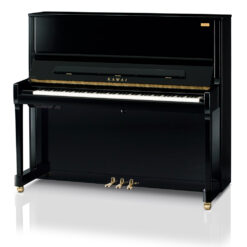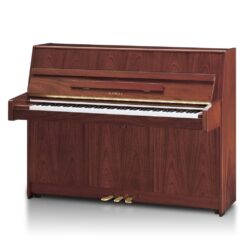C. Bechstein 118 “Contour / Classic” Upright Piano
CAD 52,054.79
-
The 118 C. Bechstein upright is available in two elegant cabinet styles: the Contour and the Classic. Both offer the same precision and detail on the inside, with slightly different treatments on the outside. As with all C. Bechstein’s, every 118 is built with the finest materials, and the highest quality control in the piano industry.
Description
Product Overview
The C. Bechstein 118 is without question one of the finest “smaller” upright pianos available in the world. Like the other entries in the C. Bechstein Masterpiece class of upright pianos, the C 118 integrates many elements used in the grand pianos of the same Masterpiece class, which accounts for their stunning level of musical possibilities.
Some of the truly premium features the C 118 boasts includes soundboards of Val Di Fieme Spruce (same wood source as the Stradivarius violins), Dark Walnut Double-felted Hammers, and Pure Copper Hand-wound Bass Strings.
A marvel of modern engineering with a production time exceeding 8 months and 180 work hours, the C. Bechstein Classic/Contour 118 might be the finest 46” upright piano available today.
Action
Bechstein reserves its “Gold Action”, their finest action available, for pianos that fall into their Masterpiece series, like the C 118. This designates the high quality of the regulation and voicing of the action, as well as the hammer’s and componentry’s precision. The extreme tolerances of these actions are due to the hours and hours of refinement they go through in the factory. This results in actions that are almost perfect from the start.
The weight and friction coefficients in specific combinations are referred to by Bechstein as their Friction Control System. Whatever the proprietary intricacies of the process may be, the C 118 undoubtedly has an incredibly responsive touch, capable of lighting fast passages and firm dynamic control. This is an upright capable of demanding classical repertoire.
Tone
The C 118 will redefine what a 46” upright was previously thought capable of for those who are used to Asian, American, and certain other European uprights. The C 118 has clearly been built to satisfy advanced pianists who play a highly demanding repertoire, with a wide spectrum of possible tonal colours, and the power and clarity required for such repertoire. Featuring its famous “bloom-like” tone, the C 118 overpowers many larger pianos due to its full cabinet activation. Made of German Red Beech, and created using CNC technology, allowing for hundredth of a millimeter precision, the bridge of the C 118 has a great deal to do its incredible sound and frequency transmission to the soundboard.
Another large contributor to this piano’s distinct tonal profile is the presence of agraffes to anchor the strings in place. Agraffes assist in creating the unique timbre of the C 118 by not only keeping the strings perfectly positioned but by determining their length and reinforcing the action’s precision. They allow the hammers of the piano to strike the optimal location on the strings that will help reinforce the fundamental tone and give greater tonal clarity.
Hammers
As the sole European piano manufacturer making their own hammerheads, Bechstein can maintain their control of the manufacturing process like few others. This allows them to create customized hammers for each specific instrument. In the globalized market in which we live, the fact that Bechstein built a production facility to make their hammerheads is quite unusual, but again shows their commitment to the control of each piano’s manufacture.
Using New Zealand wool and a top-secret, proprietary method to cover the dark walnut cores, each hammer of a C 118 is voiced by expert technicians by hand while still in the factory. This results in a wider range of dynamics, and a broader spectrum of tonal colour.
Soundboard
The Italian Red Spruce from which Stradivarius built violins is the same wood used for the soundboard of the C 118, and the only upright pianos to do so. These trees are grown at elevations above 1,000 meters in the Italian Val Di’ Fiemme, and are the source of the wonderful tone achieved by the C 118.
The design of the soundboard is that of a membrane that is tapered and fashioned to adjust its projection surface to the instrument’s unique acoustic assembly, resulting in the “bloom-like” tone. The soundboard is, thus, responsive to even slight vibrations without losing energy, and provides incredible resonance.
Cabinet
Activation of the complete structure of the piano with as little loss of energy as possible is part of Bechstein’s core philosophy of design, and this is achieved using triple joinery, long-aged wood that is incredibly stable and fitted with great precision. They also employ a mix of various hardwoods to eliminate bias.
To reduce distortion, and reinforce the sound, the piano is built using a sand-cast iron frame that can withstand 15 metric tonnes of tension, and that is mounted within solid back posts that are secured at the joints by copper beech dowels. This all ensures that the piano resonates as a whole and stays in tune. A full bass, warm mid-register, and easily produced and modulated upper treble range partials are also a result of the design and construction of the piano.
There are aesthetic cabinet differences between the Classic and Contour designs so please contact us if you would like more details on that.
Specs
| Size | Height | 46.5” (118 cm) |
| Width | 59.4” (151 cm) | |
| Depth | 23.2" (59 cm) | |
| Weight | 542 lbs. (246 kg) | |
| Finishes | Polished Ebony Polished WhitePolished Mahogany Polished Walnut Polished Cherry Satin Mahogany Satin Walnut Satin Cherry |
|
| Warranty | 5 Year Parts & Labour Manufacturer’s Warranty |
Reviews (0)
Be the first to review “C. Bechstein 118 “Contour / Classic” Upright Piano” Cancel reply
You must be logged in to post a review.
You may also like…
Upright Pianos
Upright Pianos
Upright Pianos
Upright Pianos
Related products
Upright Pianos
Kawai Hybrid
Upright Pianos
All Piano Brands
Upright Pianos
Upright Pianos
Upright Pianos
Schimmel Upright Pianos
Upright Pianos
All Piano Brands
Schimmel Upright Pianos
Schimmel Upright Pianos


















Reviews
There are no reviews yet.